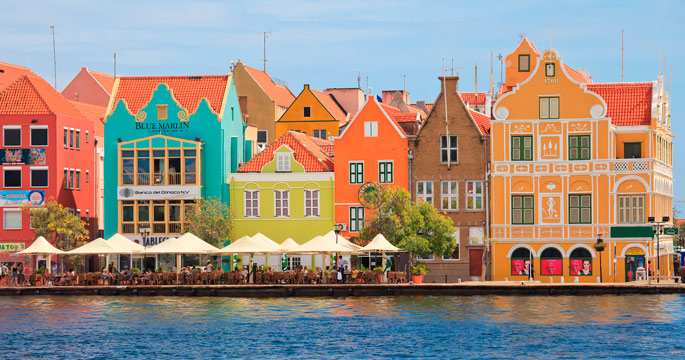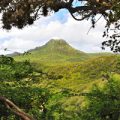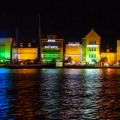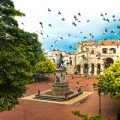From food to culture to water sports, this Caribbean island is looming large on traveler's radars
Curacao is hot. Not that kind of hot, because trade winds provide a cooling contrast to the rays of Caribbean sun. Hot as in happening, trending, on the radar. There are many reasons for this every-growing popularity, and they include everything from natural attractions to cultural charms and international appeal. Here are some of the trends that are putting Curacao on more travelers’ bucket lists.
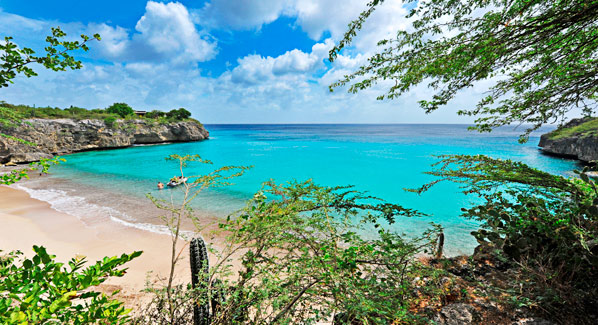
Curacao’s rocky western shoreline is cut by a series of coves that shelter secluded beaches. Coral reefs often lie within easy swimming distance. Photo: Curacao Tourist Board
Curacao has longstanding ties to the Netherlands, and Willemstad’s Punda district has been dubbed the Amsterdam of the Caribbean. The narrow cobblestone streets of this UNESCO World Heritage site are lined with 17th and 18th century buildings sporting Dutch gables, red-tiled roofs and exteriors painted in a rainbow of vibrant colors. The historic city center pulses with an international vibe that continues to attract European visitors, some who come to stay and join an eclectic culture of artists, entrepreneurs and expats.
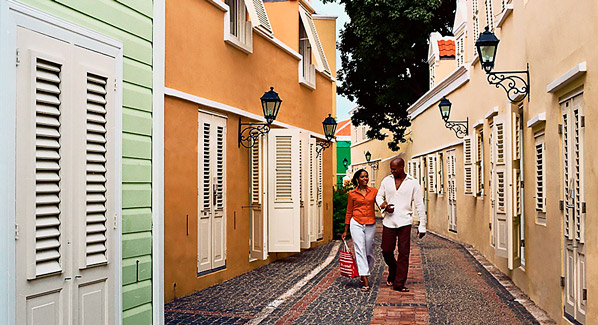
A walking tour of Willemstad including Punda and Otrabana takes in cobblestone back alleys and waterfront walkways. Highlights include Fort Amsterdam and the floating market. Photo: Curacao Tourist Board
Adding spice to Curacao’s European connection are equally strong influences from the African and Hispanic cultures of the Caribbean, and from Venezuela, which lies less than 50 miles to the south. Walk through town and you may hear the lilting tones of Papiamentu, which is a local dialogue created from a blending of Dutch, Spanish, Portuguese and African languages. And this is just the beginning of the melting pot that is Curacao. There are said to be more than 50 distinct cultural influences found on the island, as evidenced in cuisines that come from Indonesia, Africa and Italy, as well as fresh seafood, Dutch pub food and original island creations.
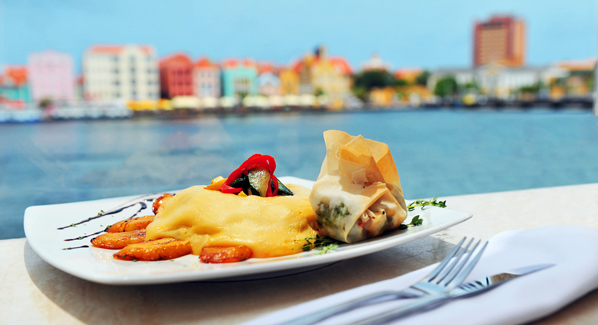
International cuisine highlights Ristoffal and sushi to homemade pasta and ravioli. Local cuisine includes Keshi Yena, a hollowed out ball of Gouda cheese stuffed with chicken or meat stew. Photo: Curacao Tourist Board
To showcase Curacao’s culinary diversity and creativity, the island’s tourism association has launched a dine-around plan with a fixed-priced menu that allows visitors to try signature flavors at more that 50 different eateries. Signature dining opportunities include beachfront meals at Karakter Curacao, water views at Boathouse, and the Fruits de Mer dinner at Baoase Culinary Beach Restaurant, where diners create their own shellfish platters that include caviar, lobster, mussels, oysters and more. Curacao’s farm-to-table movement launched at Hofi Cas Cora Plantation, with menus that rely on island-sourced produce and meats, and even vegetarians have a number of premier restaurants to choose from.
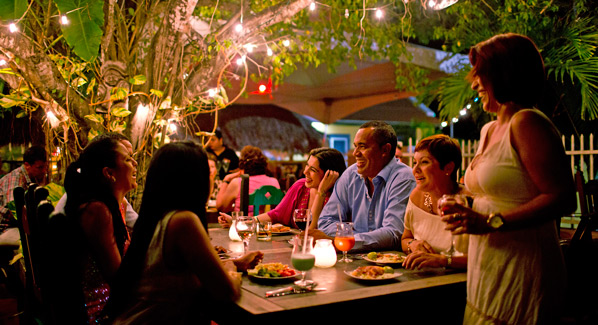
Dining in Curacao takes place in hidden gardens, ocean view beach houses, historic forts and street side cafes and is often a lingering affair. Photo: Curacao Tourist Board
Curacao is known as a place of warmth and welcome. The friendly and accommodating nature of its people sets the tone for everyday life, and can be found in the greetings of shop keepers, the lively street scene at the floating market and the conversations of patrons at local bars, where all are welcomed. Nightlife on Curacao focuses on conversation and live music, with a special appreciation for jazz. The island also attracts history buffs, who come to visit Mikve Israel-Emanuel Synagogue, the oldest synagogue in the Western Hemisphere, walk the iconic Queen Emma Bridge, and take a voyage to the lighthouse on Klein Curacao.
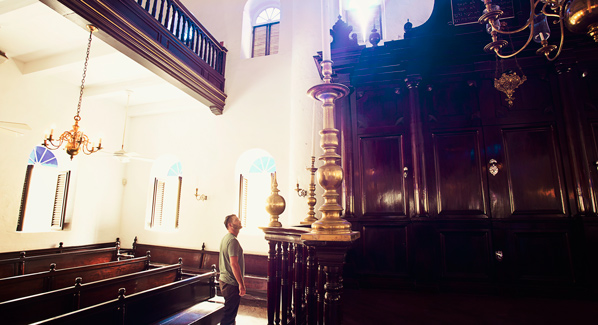
Mikve Israel-Emanuel Synagogue is the oldest synagogue in continuous use in the Western Hemisphere. Dating from 1732, the striking interior showcases large ornate menorahs and brass chandeliers and sand covered floors. Photo: Curacao Tourist Board
The hospitality that is an integral part of island culture can also be experienced at the intimate to mid-sized hotels that line the coast. A number of these properties have benefitted from recent upgrades. Avila Beach Hotel, once a Dutch governor’s mansion, is the oldest operational hotel on the island. This family-run boutique hotel recently completed a $600,000 renovation to its ocean front wing. Kontiki Beach Resort added Cabana Beach, a trendy neighboring beach club with day beds and water views and free Wi-Fi. Floris Suite Hotel is an adult’s only boutique that recently upgraded its suites and Lions Dive & Beach Resort completed renovations of apartments and suites.
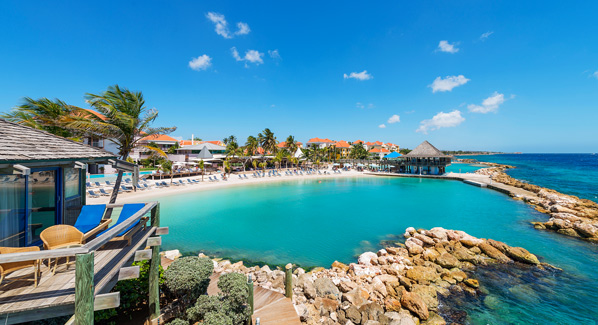
The swimming cove at Avila Beach Hotel. This resort is known for fine dining, including culinary events with Michelin Chefs from top restaurants in the Netherlands. Photo: Berber van Beek/Avila Beach Hotel
Divers and water sports enthusiasts are another group that are discovering Curacao in growing numbers. The island offers more than 65 diving and snorkeling sites that feature historic shipwrecks, colorful coral reefs and underwater slopes that plunge dramatically to depths beyond 1,000 feet. Kayakers and paddleboard enthusiasts will find a number of sheltered coves and inland lagoons to explore, while kite boarders and windsurfers skim across the flat waters of St. Joris Bay, or test their skills in offshore swell. Beach lovers gravitate to the island’s southwestern coast, where a series of bays shelter quiet beaches. This area recently came to the attention of the world when the island welcomed a group of bathing beauties for the Sports Illustrated Swimsuit 2017 issue. A different side of the coast is revealed by a visit to the west end and Shete Boka National Park, where jagged cliffs rise above pounding surf.
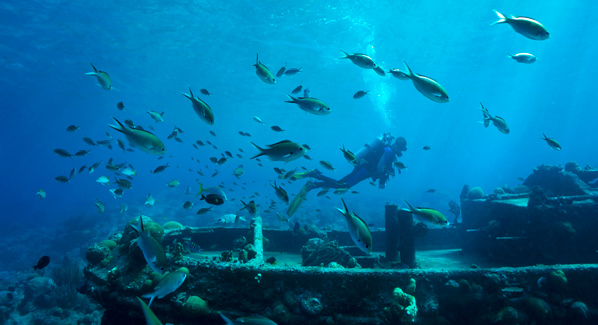
Diving and snorkeling around the island includes wrecks, walls and shallow reefs. Covered with tube spines and coral, the famous tugboat wreck sits in shallow waters. Photo: iStock
This unique combination of rugged natural beauty, local island charm and international sophistication make Curacao one of the most desirable destinations in the Caribbean. And as more visitors are learning each year, the island will keep getting hotter—but remain a very cool place to be.

